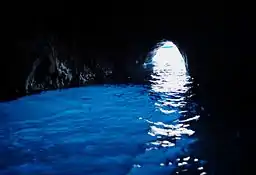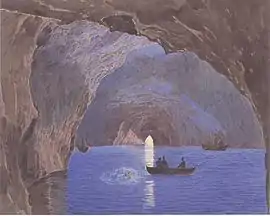Blue Grotto (Capri)
The Blue Grotto (Italian: Grotta Azzurra) is a sea cave on the coast of the island of Capri, southern Italy. Sunlight passing through an underwater cavity and shining through the seawater creates a blue reflection that illuminates the cavern. The cave extends some 50 metres into the cliff at the surface, and is about 150 metres (490 ft) deep, with a sandy bottom.[1]
| Grotta Azzurra | |
|---|---|
 Inside the Blue Grotto | |
| Location | Anacapri (NA, Campania, Italy) |
| Length | 54 m |
| Geology | Sea cave |
| Entrances | 1 |

Access
The cave is 60 metres long and 25 metres wide. The entry is two metres wide and roughly one metre high at low tide, making safe access possible only when tides are low and the sea is calm.[2] To enter the grotto, visitors must lie flat on the bottom of a small four-person rowboat. The oarsman then uses a metal chain attached to the cave walls to guide the boat inside the grotto. In 2011 a visitor suffered a life altering injury when his neck was broken while entering the cave. The Cooperativa Battellieri Grotta Azzurra initially denied liability but settled a damages claim. It was concluded that the boatmen had continued entering the cave when the sea conditions were inappropriate. Swimming in the grotto is forbidden.[3]
Colour
The Blue Grotto is one of several sea caves worldwide that is flooded with a brilliant blue or emerald light. The quality and nature of the colour in each is determined by its unique combination of depth, breadth, water clarity, and light source.
In the case of the Blue Grotto, the light comes from two sources: the narrow arched entranceway, and an aperture approximately ten times as large directly below it, separated by a band of rock between one and two meters tall. Because it is farther from the surface much less light passes through the lower opening, but its depth and size allow it to be the grotto water's primary source of illumination.
As light passes through the water into the cave, red reflections are filtered out and only blue light enters the cave. Objects placed in the water of the grotto famously appear silver. This is caused by tiny bubbles, which cover the outside of the object when they are placed underwater. The bubbles cause the light to refract differently than it does from the surrounding water and gives off the silver effect.[3]
In part because of the dazzling effect of the light from the above-water opening, it is impossible for a visitor who is in one of the rowboats to identify the shape of the larger hole, the outline of the bar that separates the two holes, or the nature of the light source, other than a general awareness that the light is coming up from underneath, and that the water in the cave is more light-filled than the air. A visitor who places a hand in the water can see it "glow" eerily in this light.
History
During Roman times, the grotto was used as the personal swimming hole of Emperor Tiberius as well as a marine temple. Tiberius moved from the Roman capital to the island of Capri in 27 AD. During Tiberius' reign, the grotto was decorated with several statues as well as resting areas around the edge of the cave. Three statues of the Roman sea gods Neptune and Triton were recovered from the floor of the grotto in 1964 and are now on display at a museum in Anacapri. Seven bases of statues were also recovered from the grotto floor in 2009. This suggests that there are at least four more statues lying on the cave's bottom.[1] The cave was described by the Roman historian Pliny the Elder as being populated with Triton "playing on a shell". The now missing arms on the recovered Triton statue – usually depicted with a conch shell, suggest that the statues recovered in 1964 are the same statues Pliny the Elder saw in the 1st century AD.[2] According to reconstructions of the original Blue Grotto, a swarm of Triton statues headed by a Neptune statue may have stood in the walls of the cave. The environmentalist association Marevivo aims to restore the Blue Grotto to its ancient glory by placing identical copies of the statues where they originally stood in the grotto. This project is being carried out in collaboration with the archaeological superintendence of Pompeii.[1]
At the back of the main cave of the Blue Grotto, three connecting passageways lead to the Sala dei Nomi, or "Room of Names", named for the graffiti signatures left by visitors over the centuries. Two more passages lead deeper into the cliffs on the side of island. It was thought that these passages were ancient stairways that led to Emperor Tiberius' palace. However, the passages are natural that narrow and then end further along.[2]
During the 18th century, the grotto was known to the locals as Gradola, after the nearby landing place of Gradola. It was avoided by sailors and islanders because it was said to be inhabited by witches and monsters. The grotto was then "rediscovered" by the public in 1826, with the visit of German writer August Kopisch and his friend Ernst Fries, who were taken to the grotto by local fisherman Angelo Ferraro.
Cultural influence
In 1826, German writer August Kopisch and his friend Ernst Fries, a German painter, visited the cave and recorded their visit in the Kopisch's Entdeckung der blauen Grotte auf der Insel Capri in 1838.
In 1842 Danish choreographer August Bournonville set the second act of his ballet Napoli in the Blue Grotto. In this fantastic tale, Golfo, the demon who rules the Blue Grotto, transforms the ballet's heroine, Teresina, into a Naiad.
Mark Twain visited the Blue Grotto in 1869 and recorded his thoughts in his book The Innocents Abroad.[2]
The grotto is highlighted in the 1953 Newbery Honor book Red Sails to Capri by Ann Weil.
In Alberto Moravia's 1954 novel Il disprezzo (Contempt), a vision appears to the protagonist when, under heavy mental stress, he visits the cave alone.
See also
- List of caves
- List of caves in Italy
- Modra špilja on island of Biševo, Croatia
- Blue Grotto, a group of sea caverns on the south coast of Malta
References
- Lorenzi, Rossella (2009-09-28). "Roman Statues Found in Blue Grotto Cave". DiscoveryNews. Retrieved 2020-12-30.
- "Blue Grotto (Grotta Azzurra)". Atlas Obscura. Retrieved 2015-11-24.
- "Grotta Azzurra - The Blue Grotto Capri - Capri Tour". Capri.com. Retrieved 2015-11-24.
External links
| Wikimedia Commons has media related to Blue Grotto (Capri). |